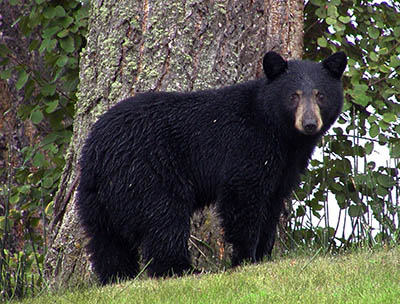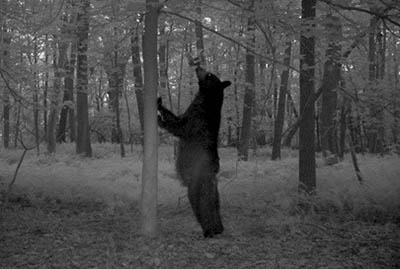
At the time of European settlement, black bears occupied all of Maryland. As settlers moved westward, valuable habitat was lost. By the 1950s, only a few bears remained in far western Maryland. Due to habitat recovery and regional conservation programs, Maryland is now home to a healthy population of bears.
Currently, Maryland has a breeding population of black bears in the four westernmost counties (Garrett, Allegany, Washington, and Frederick). Although evidence of a breeding population is confined to those western counties, the Department receives several sightings and complaints in central and southern counties each year.
To Report Bear Related Emergencies Call 1-410-260-8888
If you have persistent bear problems or want more information on bears, contact your local DNR Wildlife & Heritage Service office or one of the offices listed below.
Maryland Department of Natural Resources
Wildlife & Heritage Service
Tawes State Office Building
580 Taylor Avenue
Annapolis, MD 21401
Telephone: 410-260-8540
Toll-free in Maryland: 1-877-620-8DNR, follow the prompts to reach Wildlife and Heritage Service
TDD: 410-974-3683
Wildlife Service Offices – Western Maryland
Garrett County
Mt. Nebo Wildlife Management Area
1728 Kings Run Road
Oakland, MD 21550
301-334-4255
Western Regional Office (Allegany County)
12512 N.E. Pleasant Valley Rd
Cumberland, MD 21502
301-777-2136
Washington & Frederick Counties
Indian Springs Wildlife Management Area
14038 Blairs Valley Road
Clear Spring, MD 21722
301-842-2702
Wildlife Service Office – Central Region
(Baltimore, Carroll, Cecil, Howard, Harford and Montgomery counties and Baltimore City)
Central Region Main Office
3740 Gwynnbrook Ave.
Owings Mills, MD 21117
410-356-0941
Resources
Activities for Kids
How many bears are there in Maryland?
There are more than 2,000 adult and subadult black bears roaming the occupied counties of Maryland (Garrett, Allegany, Washington, and Frederick Counties) with sightings common throughout much of the state. Counties are considered to be occupied if a breeding population is documented.
Although Maryland biologists have researched and estimated the population size it is important to understand that the population of black bears is in a constant state of flux due to the large home range of these mammals and to their seasonal movements. In January and February, female black bears (sows) give birth in their dens every other year. Although the cubs are capable of independence within six months (by June), the family group often will stay together until the sow is ready to breed again the following year in June.
The young bears can travel great distances to find new territory and easy food sources. As a result, there are notable increases in bear/vehicle collisions and human/bear conflicts during this juvenile dispersal period in May through July.
Black bears have adapted to scarce winter food supplies by hibernating during winter months and will consume a great deal of calories to prepare for hibernation. Because of this activity, there is another peak in black bear movement in October and November.
Managing Maryland’s Black Bears
The Maryland Wildlife & Heritage Service is tasked with managing black bears in Maryland. Staff carefully work to balance the needs of both the species and a diverse public. Black bear population management is necessary to reduce human-bear conflicts and damage caused by black bears. Between 2011-2021, black bears have caused a yearly average of 480+ nuisance calls and $18,700 in agricultural damages. In addition, around 60 bears are killed each year by vehicle strikes. To address these issues and others, the Wildlife and Heritage Service has created the Maryland Black Bear Management Plan as a framework for conserving Maryland black bears.The Maryland Black Bear Management Plan has six main management goals:
Ensure that healthy black bear populations are maintained statewide.
This goal is accomplished through annual monitoring and examining population trends through a statewide Mortality, Nuisance, & Sightings Survey, the Black Bear Bait Station Survey, and the Reproduction Survey. Populations of animals with large home ranges, like bears, are extremely difficult and expensive to estimate. Population estimates were conducted in 1991, 2000 and, most recently, 2011. In addition to these actions, the Wildlife and Heritage Service has also carefully regulated a hunting season on black bears since 2004.

Trailcam photo of a Maryland black bear from a bait station survey site
-
Conserve and manage habitat for black bears.
Wildlife and Heritage Service staff work closely with public and private landowners to manage habitat for wildlife, including black bears.
-
Promote human safety, protect agricultural income, protect personal property, and address conflicts between humans and bears.
Staff frequently provide public education to local communities, homeowner’s associations, civic groups, etc. to minimize human-bear conflicts in their area. Staff have also developed pages to assist with
Living with Black Bears and
Beekeeping and Black Bears. In addition, the Information and Education program manages
black bear education trunks, has developed a
WILD at Schools black bear module, and has integrated black bear education into professional development programs like
Project WILD. To request a community program, please contact one of our regional offices listed at the
bottom of this page.
Wildlife & Heritage Service utilize regulated hunting to reduce the growth of the population and, thus, provide relief to human-bear conflicts. An overview of the hunting seasons can be found
here. A Black Bear Nuisance Response Plan has been implemented and is regularly updated to ensure that staff are using the appropriate methods and conflict resolution tools efficiently and effectively.
Finally, staff respond and work to mitigate nuisance complaints throughout the state as well as work with individuals experiencing ongoing and severe damage by providing technical support, assisting with the
Black Bear Damage Reimbursement Fund, and implementing depredation permits.
-
Ensure that public values are considered in the various bear management scenarios.
Public opinion surveys have been conducted through Responsive Management.
-
Ensure that all aspects of Maryland’s black bear management program are conducted in a professional and humane manner.
Staff are continually engaged in professional development to ensure they are using the best available science and technology to manage black bears.
-
Provide funding mechanisms to support black bear management in Maryland.
The
Black Bear Damage Reimbursement Fund provides relief to farmers that experience significant damage from bears. In addition, revenue generated through the sale of the
Black Bear Hunt Lottery is used directly for management of black bears in Maryland.
Additional Information:
Maryland Residents Attitudes Toward Black Bear Management - 2022
An Overview of the Maryland Black Bear Hunting Seasons 2004-2021
Purchase Black Bear Reimbursement Fund Stamps and Products
